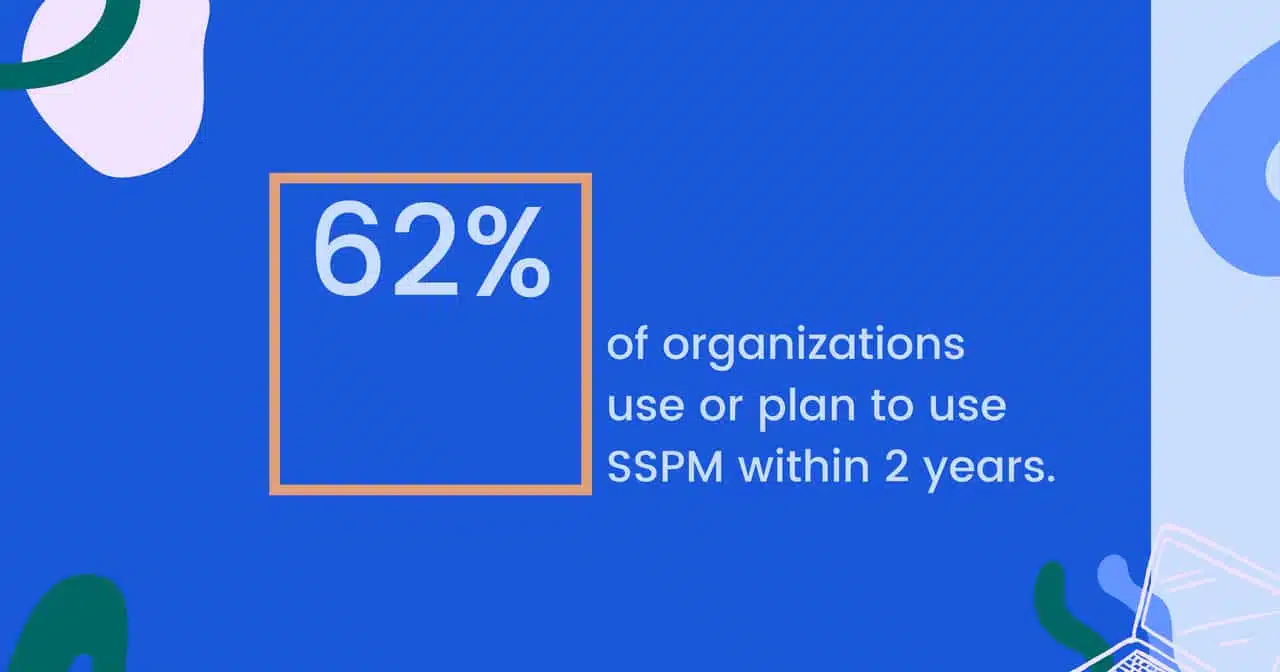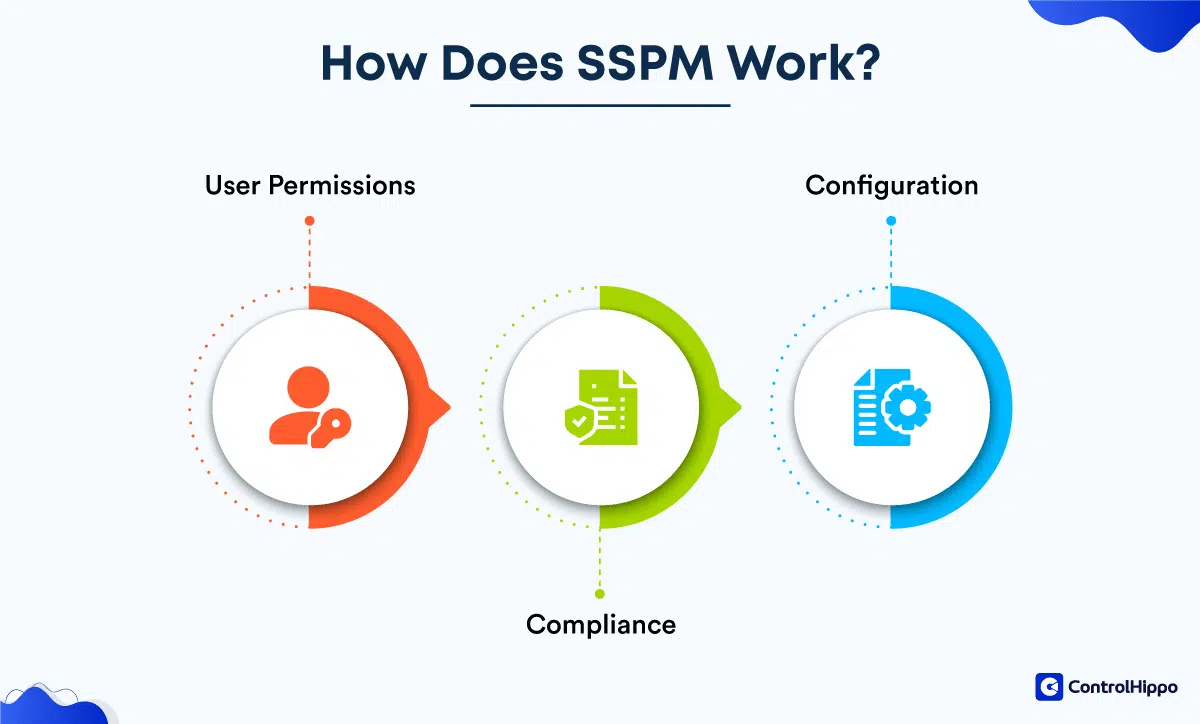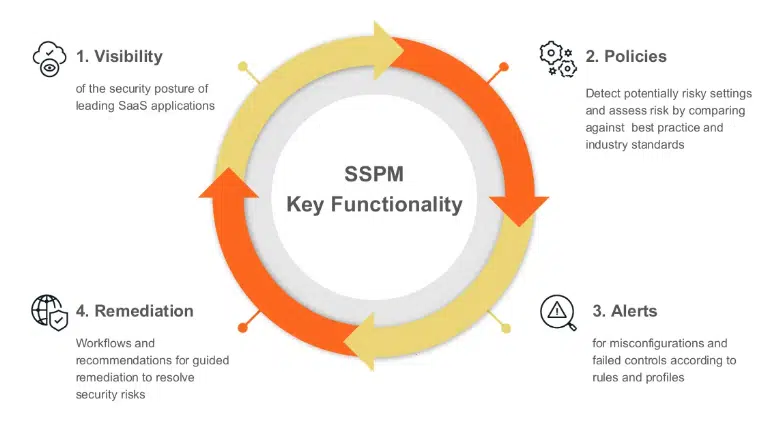As cyber threats evolve and grow, the risks associated with SaaS (Software as a Service) platforms become more apparent. While convenient and effective, these solutions introduce new challenges organizations must contend with. Adding SaaS platforms to your technological infrastructure widens your attack surface, creating new vulnerabilities attackers can exploit.
According to a recent ISACA (Information Systems Audit and Control Association) report, 48% of surveyed organizations experienced an increase in cyberattacks in 2023. With our reliance on platforms and technology continuing to expand and new cyber threats constantly emerging, we must remain vigilant about our security status.
Solving this challenge is where SaaS Security Posture Management comes into play.
What is SaaS Security Posture Management (SSPM)?
SSPM is a security management method where InfoSec teams leverage technology and automation to manage the security status of their technology stack. This is accomplished by using automated security tools to maintain a high level of visibility into the security status of the organization’s entire infrastructure, including its SaaS applications.
An effective SSPM can identify potential cybersecurity threats early, enabling swift intervention and mitigating potential consequences. The shift towards using SaaS applications for assets such as processes, user data, and CRM solutions is streamlining operations and improving efficiency.

However, increased reliance on SaaS platforms has widened the attack surface that can be used to target organizations. SSPM addresses these risks by ensuring security teams remain aware of the security status of their technological stack, allowing them to maintain strict compliance with software security regulations.
5 Things You Need to Know About SaaS Security Posture Management
1. How does SaaS Security Posture Management work?
SSPM tools regularly assess SaaS applications by focusing on several key areas.
First, SSPM carefully analyzes the actions of users within SaaS applications, and some tools can even detect and highlight inactive accounts. By deactivating accounts, potential security vulnerabilities are reduced.
SSPM can also be used to ensure compliance, as it identifies security threats that could lead to data security breaches and violations of privacy regulations.
Finally, SSPM scans for errors in security configuration, identifying vulnerabilities that might expose data. Once the risks are identified, the SSPM promptly notifies the security teams. In some cases, certain SSPM solutions can even take mitigation actions on their own.

2. What are the benefits of SaaS Security Posture Management?
Ensuring security in SaaS is no mean feat. Besides the many configurable settings, there are threats within and without the system. SSPM is a reliable partner to simplify SaaS management, providing benefits such as:
Enhancing Security Posture
Securing your SaaS portfolio is no easy task, but SSPM is up for it. It offers a straightforward approach, giving insights into who uses your SaaS apps and how. With proactive threat alerts and clear visibility, SSPM becomes your trusted guardian, guiding you on what to do if there’s a data incident, all within a user-friendly, automated platform.
Preventing Misconfigurations
In a threat landscape where security breaches are becoming more common, misconfigurations are a significant concern. SSPM identifies and warns your security team of unnecessary permissions and ensures access control is tight. Unlike many security solutions focusing only on intentional misconfigurations, SSPM takes a broader approach, alerting teams to intentional and unintentional deviations from standard procedure.

Ensuring Compliance
Keeping up with internal regulations and external security policies can be a headache, especially with so many industry-specific policies such as HIPAA, CJIS, and more in play. SSPM comes to the rescue by simplifying compliance management. It automatically tells administrators and security teams about any breaches in security features or non-compliant use, allowing for immediate reinforcement of standards.
Adapting to SaaS Changes
Change is part of the deal in the SaaS world. SSPM makes the transition smoother, keeping your organization well-informed about any changes in your SaaS portfolio, especially your security and IT teams. It eases the platform migration process and ensures that your users, including employees and customers, are well-prepared to handle these changes seamlessly.
3. What are the key features of SaaS Security Posture Management?
Securing your technological infrastructure is critical, and SSPM simplifies the process with the following key features:
1. Unified Display
SSPM makes monitoring a breeze by putting all the crucial information in one place. Everything you need, from user details to potential threats, is neatly organized on a single dashboard. This user-friendly setup empowers your team with the tools to manage risks as soon as possible and keep your business safe.
2. Threat Detection
SSPM is the key to visibility, detecting any threats lurking in your digital infrastructure. It automatically notifies your security officers of suspicious activities, such as misconfigurations of policies.
3. Remediation
The enhanced visibility provided by SSPM allows issues to be identified faster than ever. With constant monitoring, immediate remediation becomes a crucial part of your defense. SSPM works around the clock, swiftly neutralizing threats before they impact your organization.
4. Security Benchmarks
SSPM doesn’t just stop at detecting and fixing issues. It also ensures that your security aligns with industry standards. Through evaluation of activities and auditing, SSPM identifies potential weak points and assesses compliance with the security standards.
You can customize SSPM to meet the exact requirements of your organization through close working collaboration with your security team and auditors. Such a rigorous approach helps maintain compliance and enhances data security across different areas.

4. What are the must-have capabilities of SaaS Security Posture Management?
SSPM is designed to support your security infrastructure. Choosing an SSPM solution that will smoothly fit with your current apps is essential. The world of digital technology is dynamic, and it’s vital to ensure that any solution you choose doesn’t just fit with your current solutions and future additions.
Look for systems that can handle at least 60 integrations to adapt to your organization’s changes. After integration, check how well SSPM covers different security areas. Important aspects include:
- Identity and access management
- Access control for external users
- Compliance with policies
- Data leakage protection
- Auditing
- Privacy control
- Malware protection
Make sure the SSPM you choose follows industry standards. Quick detection and response are other crucial capabilities for an SSPM solution. Keep an eye out for valuable capabilities such as real-time alerts for configuration changes or risks, activity monitoring for privileged users, and a timeline view of your SaaS environment to keep track of changes.

5. Best Practices for SaaS Security Posture Management
As cyber threats evolve, so should the solutions designed to combat them. Implementing security best practices can help you make the most out of SaaS Security Posture Management and keep your digital infrastructure safe. These practices include:
Encryption
Safeguarding information from cyber threats is crucial. With encryption, every piece of data, from internal communications to customer interactions, becomes unreadable to cyber attackers, even if they manage to penetrate your defenses.
Backup User Data in Multiple Locations
Effective customer data management requires backups in multiple locations for disaster recovery. Regular and timely backups on cloud platforms prevent compromising the entire infrastructure in case of system failure.
Customer Education
A recent report from Gartner indicates that through 2024, 99% of cloud security failures will originate from consumer actions. During onboarding, educate users about data safety best practices. Informed customers act as an additional security layer for your organization.
Developing robust security awareness employee training gives your team the tools they need to work hand-in-hand with your SaaS solutions to create a more comprehensive security system. Platforms like CybeReady, integrated seamlessly into your cybersecurity strategy, offer training programs that empower your team to be ready for potential cyber threats.
Compulsory Strong Passwords
Virtual security cannot exist without strong passwords. Imposing strong password policies prevents hackers from attempting to infiltrate your organization with publicly available information. This protects your organization from falling victim to data breaches caused by account infiltration.
Navigating SaaS Security with SSPM and CybeReady
SaaS platforms are a convenient solution with many benefits for users, but they raise valid security concerns. SaaS Security Posture Management blends tech and automation to address the challenges of these third-party solutions.
While SSPM solves many challenges, no technology is foolproof. To make the most of the added security SSPM offers, it’s essential to implement best practices concurrently—and employee awareness and education are especially critical.
Empowering your team with the knowledge to identify and act on cyber threats supports early intervention efforts and compensates for areas where technological solutions may fall short. CybeReady’s security awareness training programs help you develop a security-aware company culture effortlessly with engaging, comprehensive training programs.
Contact CybeReady to discover how to enhance your organization’s defensive posture with our training programs.












